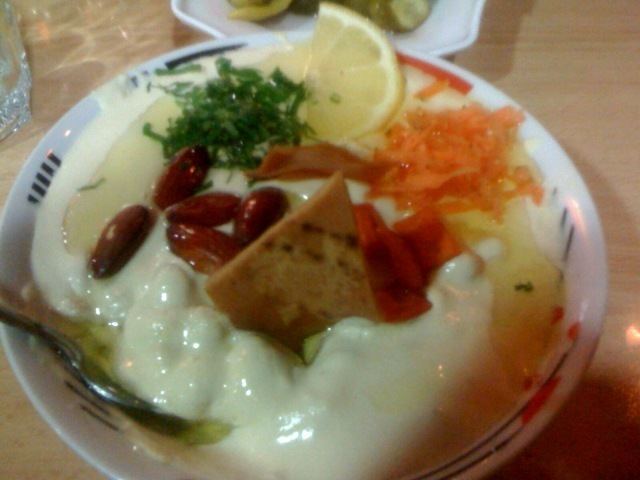 | ||
Syrian cuisine is a diffusion of the cultures of civilizations that settled in Syria, particularly during and after the Islamic era beginning with the Arab Umayyad conquest, then the eventual Persian-influenced Abbasids and ending with the strong influences of Turkish cuisine, resulting from the coming of the Ottoman Turks. It is in many ways similar to other (Greater Syria) Levantine cuisines, mainly Lebanese, Palestinian, Jordanian and Iraqi.
Contents
Syrian cuisine includes dishes like kibbeh, kebab halabi, waraq `inab, hummus, tabbouleh, fattoush, labneh, shawarma, mujaddara, shanklish, bastirma, sujuk and baklava. Syrians often serve selections of appetizers, known as "meze", before the main course, and za`atar, minced beef, and cheese manaqish as hors d'oeuvres. Arabic flat bread is always eaten together with meze. Syrians also make cookies/biscuits called "ka`ak", to usually accompany their cheese. These are made of farina and other ingredients, rolled out, shaped into rings and baked. Another form of a similar cookie is filled with crushed dates mixed with butter to eat with jibbneh mashallale, a string cheese made of curd cheese pulled and twisted together. A spice mixture called "baharat mushakalah" is endemic to Syrian cuisine.
Foods
Muhammara, is a hot pepper dip originally from Aleppo, Syria, found in Levantine and Turkish cuisines. In western Turkey, muhammara is referred to as acuka.
Aleppo pepper, Also known as the Halaby pepper, it starts as pods, which ripen to a burgundy color, and then are semi-dried, de-seeded, then crushed or coarsely ground. The pepper flakes are known in Turkey as pul biber. The pepper is named after Aleppo, a long-inhabited city along the Silk Road in northern Syria, and is grown in Syria and Turkey.
Fattoush, is a Levantine bread salad made from toasted or fried pieces of pita bread (khubz 'arabi) combined with mixed greens and other vegetables, such as radishes and tomatoes. Fattoush belongs to the family of dishes known as fattat (plural) or fatta, which use stale flatbread as a base.
Shanklish is typically formed into balls of approximately 6 cm diameter, which are often covered in za'atar and Aleppo pepper, and then aged and dried. The most common spice is thyme, thus giving the cheese its appearance somewhat resembling a dirty tennis ball. Shanklish is also sold in much smaller balls or unformed.
Vine leaves
There are two types of stuffed vine leaves in Syria:
Fattah
Fattah is prepared in a wide variety of ways, including:
Kebab Halabi
Kebab Halabi (كباب حلبي / kibāb Ḥalabī) is a kind of kebab served with a spicy tomato sauce and Aleppo pepper, very common in Syria and Lebanon, named after the city of Aleppo (Ḥalab). Kebab Halabi has around 26 variants, including:
Kibbeh
A variety of Syrian dishes made with bulgur and minced lamb are called "kibbeh" (كِبّة / kubbah). Aleppo is famous for having more than 17 different types of kibbeh. These include kibbeh prepared with sumac (كِبّة سمّاقية / kubbah summāqīyah), yogurt (كِبّة لبنية / kubbah labanīyah), quince (كِبّة سفرجلية / kubbah safarjalīyah), lemon juice (كِبّة حامض / kubbah ḥāmḍa), pomegranate sauce, cherry sauce, and other varieties, such as the "disk" kibbeh (kubbah qrāṣ), the "plate" kibbeh (كِبّة بالصينية / kubbah bi-aṣ-ṣīnīyah) and the raw kibbeh (كبة نية / kubbah nayyah).
However, kibbeh Halab is an Iraqi version of kibbeh made with a rice crust and named after Aleppo.
Mahshi
Mahshi (محشي / maḥshī) is a famous dish served in Syria. It is essentially zucchini (كوسا / kūsā) or eggplant (باذنجان / bādhinjān) stuffed with ground beef or lamb, nuts and rice.
Street food
Syrian street food includes:
Sweets
Sweets include:
